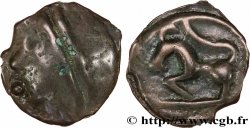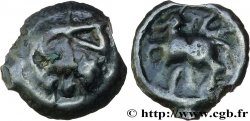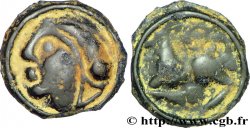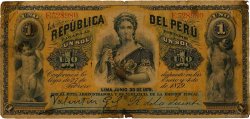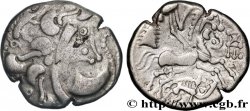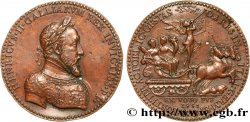bga_946121 - GALLIA BELGICA - SEQUANI (Area of Besançon) Obole à la croix, MASO tête à droite, type du coin d’Arbois
Not available.
Item sold on our e-shop (2024)
Price : 230.00 €
Item sold on our e-shop (2024)
Price : 230.00 €
Type : Obole à la croix, MASO tête à droite, type du coin d’Arbois
Date: c. 80-50 AC.
Metal : silver
Diameter : 10 mm
Orientation dies : 11 h.
Weight : 0,38 g.
Rarity : R2
Coments on the condition:
Flan centré, de for me irrégulière. Usure superficielle. Patine grise
Catalogue references :
Obverse
Obverse legend : ANÉPIGRAPHE.
Obverse description : Tête stylisée à droite, la chevelure formée par des esses ; grènetis.
Reverse
Reverse legend : M/A/S/.O. (LE A EN FORME DE DELTA).
Reverse description : Roue avec une lettre dans chaque canton.
Commentary
Il existe de nombreuses variantes pour ces très rares oboles ! Le droit peut avoir une tête à droite ou à gauche, avec ou sans la croisette dans la chevelure. Le revers peut aussi présenter plusieurs combinaisons de lettres ; MASO ou MAOS.
Selon l’étude qui a été réalisée à l’occasion de la publication du coin d’Arbois, cet exemplaire avec la tête à droite et la légende MASO appartiendrait à la classe I, variante plus rare au profil à droite, mais avec la légende MASO et non pas MAOS comme c’est le cas sur le coin.
L’attribution à l’Est de la France, autour du Jura est probable au vu de récentes découvertes. Il semble qu’il y ait eu des confusions entre les monnaies de ce type, et les imitations de Marseille épigraphes MSAO, émises dans la vallée du Rhône ou plus précisément par les Allobroges (cf. DT. 3173).
En recherchant des références pour cette obole, on se rend compte qu’il s’agit d’un monnayage très rare et curieusement absent de la plupart des publications et des collections publiées.
Ce type semble indirectement copié sur les oboles de Marseille. Il présente aussi certaines similitudes avec les oboles à la croix des Volques Tectosages
.
There are many variations for these very rare obols! The right can have a head on the right or on the left, with or without the cross in the hair. The reverse can also have several combinations of letters; MASO or MAOS.
According to the study which was carried out on the occasion of the publication of the coin d'Arbois, this example with the head on the right and the legend MASO would belong to class I, a rarer variant with the profile on the right, but with the legend MASO and not MAOS as is the case on the corner.
The attribution to the East of France, around the Jura is probable in view of recent discoveries. It seems that there was confusion between coins of this type, and the imitations of Marseille epigraphs MSAO, issued in the Rhône valley or more precisely by the Allobroges (cf. D.T.. 3173).
By searching for references for this obol, we realize that it is a very rare coinage and curiously absent from most publications and published collections..
This type seems indirectly copied from the obols of Marseille. It also has certain similarities with the obols on the cross of the Volques Tectosages
Selon l’étude qui a été réalisée à l’occasion de la publication du coin d’Arbois, cet exemplaire avec la tête à droite et la légende MASO appartiendrait à la classe I, variante plus rare au profil à droite, mais avec la légende MASO et non pas MAOS comme c’est le cas sur le coin.
L’attribution à l’Est de la France, autour du Jura est probable au vu de récentes découvertes. Il semble qu’il y ait eu des confusions entre les monnaies de ce type, et les imitations de Marseille épigraphes MSAO, émises dans la vallée du Rhône ou plus précisément par les Allobroges (cf. DT. 3173).
En recherchant des références pour cette obole, on se rend compte qu’il s’agit d’un monnayage très rare et curieusement absent de la plupart des publications et des collections publiées.
Ce type semble indirectement copié sur les oboles de Marseille. Il présente aussi certaines similitudes avec les oboles à la croix des Volques Tectosages
.
There are many variations for these very rare obols! The right can have a head on the right or on the left, with or without the cross in the hair. The reverse can also have several combinations of letters; MASO or MAOS.
According to the study which was carried out on the occasion of the publication of the coin d'Arbois, this example with the head on the right and the legend MASO would belong to class I, a rarer variant with the profile on the right, but with the legend MASO and not MAOS as is the case on the corner.
The attribution to the East of France, around the Jura is probable in view of recent discoveries. It seems that there was confusion between coins of this type, and the imitations of Marseille epigraphs MSAO, issued in the Rhône valley or more precisely by the Allobroges (cf. D.T.. 3173).
By searching for references for this obol, we realize that it is a very rare coinage and curiously absent from most publications and published collections..
This type seems indirectly copied from the obols of Marseille. It also has certain similarities with the obols on the cross of the Volques Tectosages








 Report a mistake
Report a mistake Print the page
Print the page Share my selection
Share my selection Ask a question
Ask a question Consign / sell
Consign / sell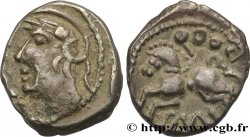
 Full data
Full data
